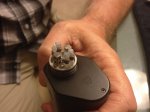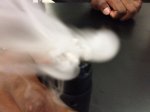Cool man. I realize it's not for everybody and I was extremely skeptical as I read up on this stuff in '12. I do know the debris can be mitigated. It was a problem for me as I'm skin sensitive. Just have to be consistent in handling it and not rush. When I demo the product live to prospective and experienced vapers they're shocked. It is key tho to make a good appropriately tight consistent coil. Or you may not see the flow advantage. So diameters are limited to a small range for both the 2 and 3 mm and building a properly oxidized tensioned micro adds significantly to concentrate power. The media can definitely handle that as demonstrated by the above pic. And IT'S NOT that a great deal of power was applied. It's how much the media absorbs, its excellent conductivity. Again visible in the above pic by it's great distribution of vapor along the length of the wick! So you have vapor compression within the closed contact wind and excellent inflow of air volume to support production along with rapid exodus of vapor.
When I first saw this work right, this synergy of forces, as I tested Nextel extensively in KPT's I was truly blown away.
Haven't gotten yet to the point of trying to take advantage of the potential on really big builds using the 4mm media but I hope to this year. The expectation being that we should be able to achieve some impressive vapor density and volume avoiding the high temp's typical for such production.
RBA appears to be rebuilding their website…
RBA Supplies LLC.
Finally I'd encourange everyone to do their own due diligence on every type of media. For reasons I've written about here on VU and elsewhere, I truly believe it's one of the safer alternatives applying the reasonable measures suggested. Makes things far easier in several respects like upkeep and longevity but it has its own nuances just as any other media for both safety and quality results.
Good luck.

p.s. Lightly wet the wick ends with VG for coil insertion. I use a pointed needle-nose tweezers to compress the wick tip and put it all the way through the coil, or well through. Then withdraw the tweezer and rotate the wick into its working position. When done, wipe the ends with a moistened paper towel. Don't use tissues. This may leave more residue than the fragments you're taking off. And nothing will clog a wick faster than paper dust.





